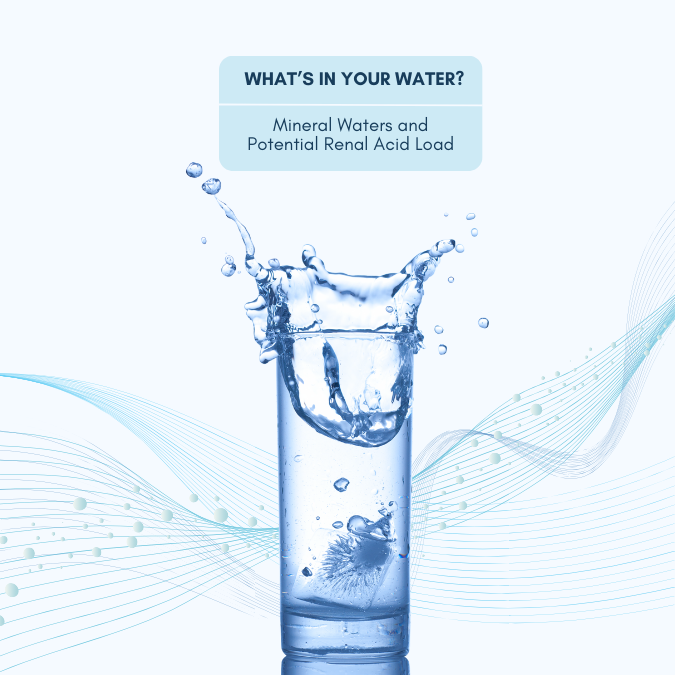I have talked a lot about metabolic acidosis and the impact of diet to help correct CO2 levels, but what about beverages? Can what people drink impact CO2 levels?
Easy answer – probably yes. Let’s see what the literature has to say.
Today’s articles:
Why might drinks have an impact on CO2 levels?
There is growing interest in how dietary acid load, often evaluated using Potential Renal Acid Load (PRAL) formula impacts acidosis among those living with CKD. According to this study of 100 adults living with Stage 3 and 4 CKD, the higher the PRAL the lower the sodium bicarbonate levels were (the more acidic the blood was). In fact, the authors reported that for every 1 unit increase in PRAL the CO2 levels reduced by 0.25mmol/L.
To this end, it isn’t surprising that several studies have examined the impact of drinking alkaline water on CO2 levels.
What did the studies do?
In all of these studies, healthy subjects were switched to mineral waters with different levels of alkalinity. The doses were between 1500-2000L per day for both the Mansouri and Wasserfurth study, in the Heil study, subjects were just to replace all their water with the tested water. In these studies, both the urine and blood was tested for indicators of changes of pH.
What did the studies find?
Among those who consumed the mineral water the CO2 levels increased (representing less acidic blood). Urine samples also suggested that the bicarbonate waters reduced urine acidity.
What is mineral water?
According to Health Canada, Mineral water is water that comes from an underground source, not part of a community water supply that is safe to drink. Mineral water general contains more dissolved minerals than spring water.
In Canada, the label for both Spring and Mineral Water must include:
- Dissolved mineral salt content
- Statement indicating whether ozone for fluoride has been added
- Statement about where the water was found (the source)
How are mineral waters assessed to determine their alkalinity and PRAL?
The PRAL index was calculated for each individual water with the following nutrients using the formula:
PRAL (mEq/L) = chloride (mg/day) * 0.03
+ protein (g/day) * 0.49
– (K(mg/day) * 0.021
– Mg (mg/day) * 0.026
– Ca (mg/day) * 0.013
– Na (mg/day) * 0.0413
Based on this formula you can see that protein and chloride are considered acidifying components since the increase the PRAL score. Potassium, Magnesium, Calcium and Sodium lower the PRAL score.
Is the bicarbonate content or the PRAL score more important?
In the study that compared 4 waters, the authors reported that the second highest bicarbonate content showed the biggest impact on CO2 levels, leading the authors to hypothesize that the PRAL score is likely more important than the bicarbonate content.
However, the alkalinity seemed to be more important in impacting the urine pH, which is kidney-mediated.
So the easy answer… Not sure!
Do we need to worry about the potassium and phosphorus content of mineral waters?
In general no. Mineral waters tend to be low in both potassium and phosphorus, though hopefully this can be confirmed using the information provided on the label.
What are the PRALs of some of the common waters available in Canada?
When I did a quick google search, these were some of the more common mineral waters available. I calculated PRAL score using the formula above.
| Brand | Bicarbonate Content (mg/L or ppm) | PRAL Score | Data Source |
| San Pelligrino | 239* | -2.69 | https://www.sanpellegrino.com/us/sites/g/files/xknfdk2166/files/2023-03/EN_Water_Analysis_Report_2022.pdf |
| Montellier | 77 | 0.33 | https://www.montellier.ca/product/natural/ |
| Perrier | 445 | -2.26 | Unable to find company information online – source is from https://www.mineral-calculator.com/compare-waters/2162/ |
| Evian | 360 | -1.47 | https://www.evian.com/en_us/natural-spring-water/bottled-water/500ml |
| Gerolsteiner | 1816 | -11.36 | https://www.gerolsteiner.de/en/water-knowledge/minerals-and-mineral-water/bicarbonate |
| Badoit | 1200 | -10.47 | https://aquacarpatica.com/wp-content/uploads/2018/03/BADOIT-SPARKLING_A-00165610.pdf |
- Remember that if a product reports ppm that is the same as mg/L
- *Source is from https://www.mineral-calculator.com/compare-waters/2162/
What about Alkaline Waters?
There are starting to be products marketed as Alkaline Waters. It appears the waters are considered alkaline because of added potassium, magnesium and calcium. Unfortunately, I wasn’t able to find enough nutrition information on the product websites to calculate PRAL. Let me know if you find any products that provide that level of detail!
What about Sparkling Waters?
Because many sparkling waters (e.g. Bubly) are not mineral or spring waters they do not need to report their mineral content breakdown and so I was unable to calculate PRAL scores on any of the products I looked up.
What is a good PRAL score and bicarbonate value?
According to the studies review, the threshold of bicarbonate was set at 1818mg/L or >29.7mmol/L and the PRAL score of less than -10.8.
So, in Canada if wanted to use these products with your patients you would need to recommend either the Badoit or the Gerolsteiner waters.
Take Aways
In the general population it has been well documented that water can impact dietary acid load and markers of acidosis. I was unable to find a study using this intervention in the kidney population, however given the relatively low potassium and phosphorus content of these products this intervention is likely safe.
In my practice I have used this intervention with success to help raise CO2 levels, especially for my patients who aren’t tolerating sodium bicarbonate tablets or don’t want to add medications. It is a big commitment on the part of the patient, but for some people it can be the right intervention!



